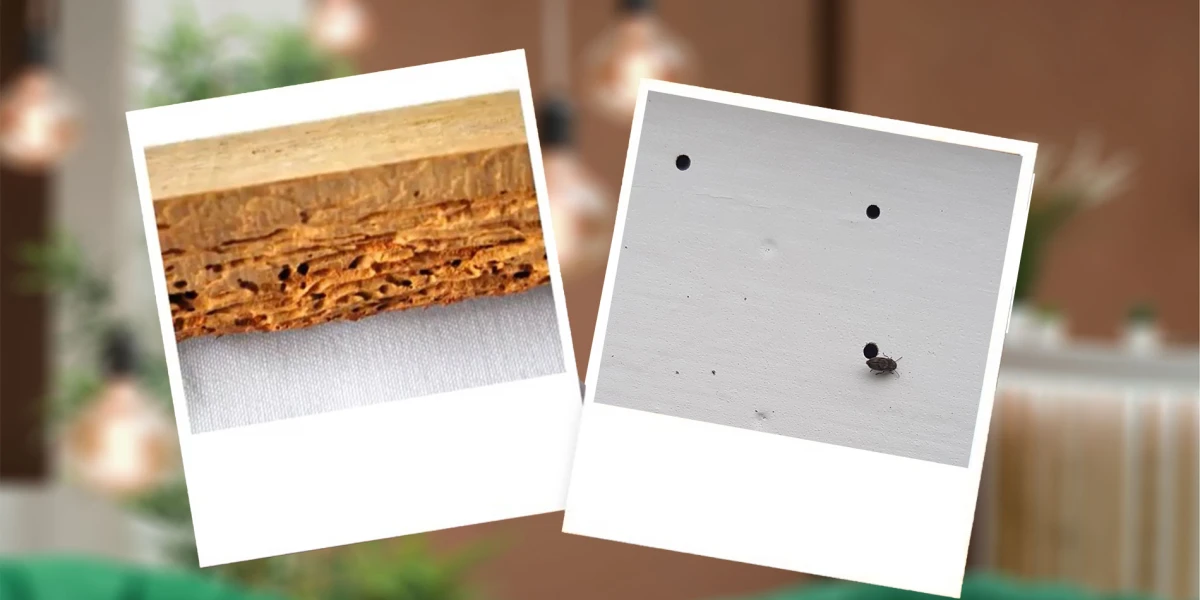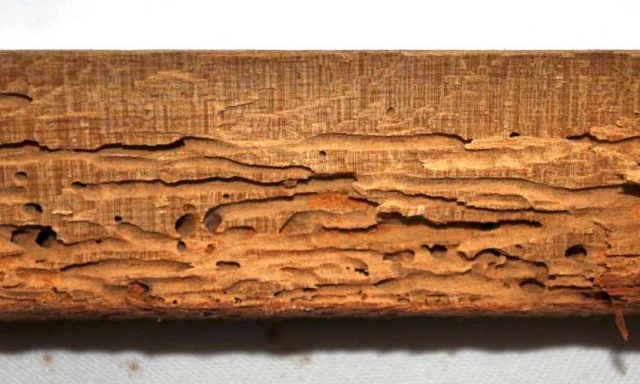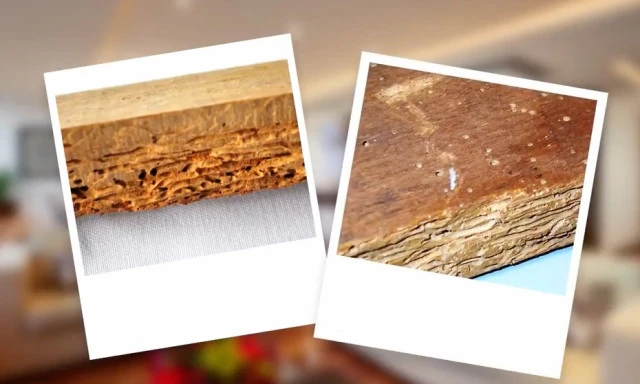Act Fast When You Spot Borer Damage
Whether it’s in your home’s timber framing or a treasured piece of wooden furniture, small round exit holes and fine dust (frass) are clear signs of a borer infestation. Borer infestations can quickly spread and cause serious damage if left untreated. Our team of experts has developed and easy DIY 1-2-3 Step Borer Control Programme that you can implement at any time to kill off borer before they breed and cause more damage.
Looking for Evidence of Borer

Common Borer
The places most likely to have borer damage are cool, slightly damper areas of buildings like sub-floors, south facing walls, laundries, eves etc. Also don’t forget to check your wooden furniture. Look for small holes often times there are several holes in the same area. In some cases, small piles of dust under the holes where the borer beetle has tunneled out. Most of the time you will not see the borer larvae or the beetle, but on rare occasions the beetle will congregate on windowsills or corners of the rooms in your house. There are seven different species of borer in New Zealand, but Common Borer and Native Borer are the little brown beetles that you are most likely to find on your property.
Kiwicare's 1-2-3 Step Borer Control Programme
- Step 1: Protect
The best option is always to protect the wood directly by treating it with long lasting NO Borer Total Wood Protection.
Bare/Uncoated Wood: Treat any bare wood with NO Borer Total Wood Protection. This product is available in both Concentrate and a Ready To Use Spray. It will penetrate deep into the timber and in normal circumstances protect the wood for many years. Small areas where solvent cannot be used can be treated with NO Borer Total Wood Protection ready to use trigger spray.
Painted/Varnished/Polished Wood: Inject flight holes with NO Borer Spray Injector. The aerosol forces insecticide into the labyrinth created by the borer larva, killing any larva in the labyrinth or nearby. It also prevents adult beetles laying eggs in the flight hole.
- Step 2: Fumigate (or Bug Bomb)
Treat with NO Bugs Super Fumigator between October and March to quickly knock down adult beetles before they mate and re-infest wood.
NO Bugs Super Bug Bombs can be used as an alternative in spaces with high roofs/ceilings.
Fumigation/Bug Bombs are often the only option for treating homes and buildings where all the timbers cannot be easily accessed with sprays and injectors.
NOTE: Fumigators are recommended because their slow release vapour tends to penetrate deeper than aerosol based bug bombs and given how well borer hides, it's best to get as deep into wood as possible. Bug bombs however are recommended when fumigators are not available or when dealing with high roof spaces, as due the aerosol nature and lighter weight droplets bug bomb treatments can reach higher than a fumigator.
- Step 3: Ventilate & Dry
Borer prefer timber that has some moisture in it. Ensure that your sub-floor and roof spaces are dry and well ventilated. Check for plumbing leaks and unblock all air vents.
Caution
Keep all animals out of the area being treated during treatment and until all sprays have dried completely.
More Tips & Advice
- Watch this short video for more information on control of wood damaging pests.
- Click on the button below for more tailored advice on protecting buildings.
Facts About Wood Eating Pests In New Zealand
NZ’s Most Widespread Borer
There are two very similar species the Common Borer (Annobium punctatum) and Native Borer(Leanobium flavomaculatum) that are widespread throughout New Zealand. They are pests of major economic importance in New Zealand, the significance of which is not yet adequately recognised. As New Zealand houses get older the damage to timbers accumulates and attacked timbers become progressively weaker. It is not uncommon for weatherboards, floorboards, joists and other structural timbers to need replacing due to weakness caused by borer. The holes and labyrinths created by borer larvae also allow water to penetrate many timbers and increases rot by fungi.
The larvae (woodworm), after 2 - 4 years spent tunnelling inside the wood will exit as an adult beetle via a round hole, 1 - 2mm in diameter. Cutting out this trapdoor is their final wood destroying act. They emerge in order to breed, will not eat any more timber and will die within 3 - 4 weeks.
Life Cycle for Common & Native Borer:
- Egg-larvae: 14-28 days
- Larvae-pupae 2-3 years: Attacks only soft sapwoods.
- Pupae-adult: 21-60 days
- Adult-beetle 3-4 weeks: Exits wood October - March
- Look for: Rounded holes 1-2mm in size.
About Other Wood Damaging Pests
The Longhorn borer beetles include the Two-Toothed Longhorn, (Ambeodontus tristis), Burnt Pine Longhorn and Huhu grub beetles. The grubs or larvae of these beetles feed on dead timber and the Two-Toothed is a major pest damaging timbers in buildings and damaging timber in the timber industry.
Longhorn beetles are long, with narrow bodies and very long antennae. The adult beetles may be found on flowers where they feed on nectar but the adults of some species adults do not feed at all.
Longhorn beetles are much larger than house borer beetles. The larvae of Two-Tooth borer often cause severe damage to Rimu floors and other timbers. As well as being larger than common borer flight holes, the Two Toothed Borer flight holes are approximately 3-4mm across, the flight holes of Longhorn beetles tend to be oval rather than round.
Life Cycle for Longhorn Beetles:
- 5 - 7 years: Inside wood.
- Exit wood: March-May.
- Look for: Oval holes 2mm x 6mm.
- Attack: Soft wood & heart wood.
Termites
Termites also cause damage to timbers. There are both native and introduced termites in New Zealand.
These can cause significant damage to timbers and have significant differences in habits and treatments and so are dealt with in a separate document. If you suspect termites go to Kiwicare.co.nz for further advice.


